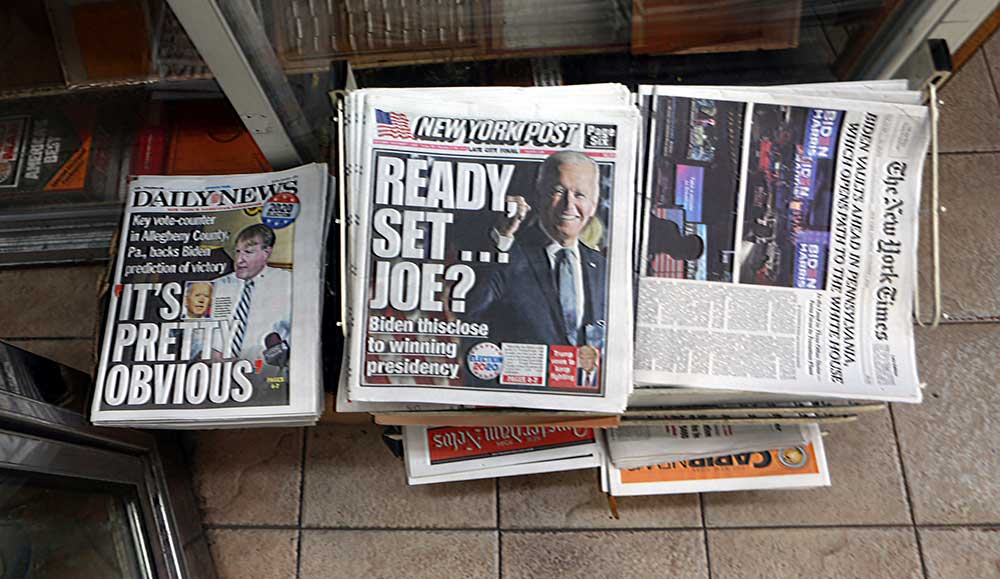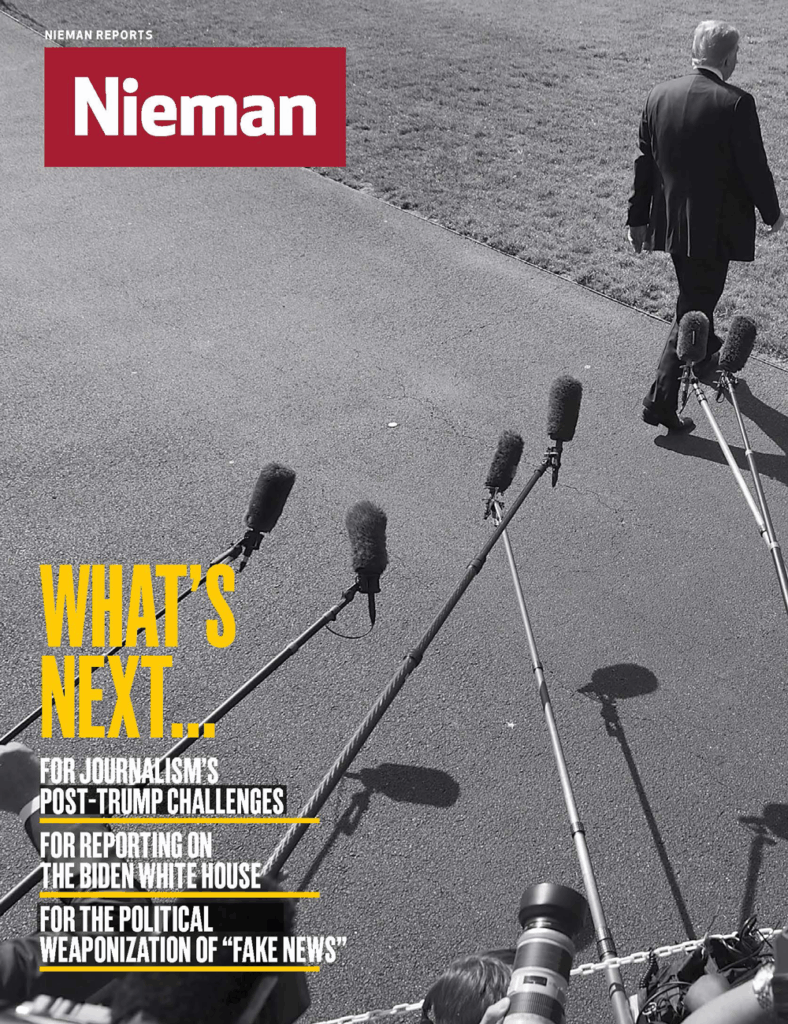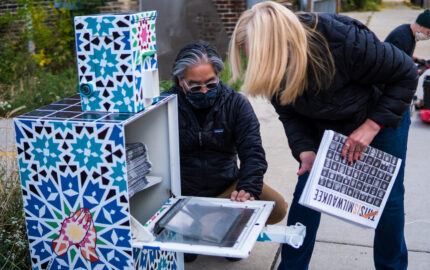When political writer Seema Mehta of the Los Angeles Times hit the trail to cover Election Day voting in Michigan, she had some new equipment in her bag: Gas mask. Helmet. Goggles. “It was a little surreal,” she says. “This is my fourth presidential, and it’s the first time I've been fitted for a gas mask and handed riot gear.”
Reporters needing to outfit themselves like war correspondents just to cover the American political process is emblematic of how the practice of journalism — and the problems facing the press — have changed in the Age of Trump.
During Trump’s tenure, as reporters have well documented, America has seen a rise in open expressions of white nationalism and other forms of extremism. Meanwhile, suspicion of the media is rampant. As many as half of Americans have said they distrust information disseminated by the media about the deadly coronavirus. “Alternative facts.” Hyperpartisanship and polarization. The dismantling of political traditions and norms.
All of it was on display for the world at 2:21 a.m. on election night, when the president, speaking from the White House as his hopes for a second term stood imperiled, announced that the democratic process itself should not be trusted.
Despite the election victory of Joe Biden and Kamala Harris, what is already clear is that these problems are not going away anytime soon. Here is a look at key challenges that, for both the press and the public, will remain.
The assault on facts will continue
Shortly before the 2020 election, a survey by STAT, the Boston-based outlet focused on health, science, and medicine, in conjunction with The Harris Poll, found that the percentage of Americans who said they were likely to get a Covid-19 vaccine as soon as it came online was falling, especially among Black Americans. The findings concern STAT executive editor Rick Berke, who says they point to a decrease of trust in scientific institutions and government.
“Scientists obviously are not infallible and should always be questioned, but I’ve never seen such an extraordinary politicization of science, with health officials being questioned about the very basic, straightforward steps to protect us all, [such as] wearing masks” during the pandemic, Berke says. The “public confidence in science and health officials that were sort of always assumed [to] have the last word on public health issues is no longer a sure thing.”
In the period around Election Day, the United States found itself grappling with 10 million cases of coronavirus and more than 237,000 deaths, a new record high of more than 100,000 new cases per day. Former Trump advisor Steve Bannon got his Twitter account suspended for saying Dr. Anthony Fauci, the country’s top infectious-disease authority, should have his head on a pike. There’s been some positive news as well, including encouraging early results from a Pfizer vaccine trial.
Moving ahead, Berke foresees major issues for leading health and science agencies. “This is going to be an enduring problem, [where] you can’t uncouple the politics from science so easily anymore. Science is now open season for partisan attacks and wrangling, and it would be irresponsible for us not to write about that.”
Public disagreement about basic facts — and disputes over coverage of them — is hardly limited to the health space, says David Folkenflik, media correspondent for National Public Radio.
“We’re going to have a lot of severe questioning of the good faith of major institutions, including the press,” he says. “It includes government agencies that aren’t partisan outfits ... The press has to figure out a way to convey faith in itself — and in other similar, somewhat analogous institutions — without papering over flaws and shortcomings and problems in them.”
The challenge comes as Trump continues to claim without evidence that he won an election massively tarred by Democratic voter fraud — and one that resulted in a Republican proponent of the inflammatory and baseless QAnon conspiracy theory being elected to the House from Georgia.
Amid all this controversy, “Journalists have to do their job [and] prove their value,” Folkenflik says. “For conservatives who mistrust the press, they’ll find if we serve them well, that … there may be wrongs righted, or scandals exposed by the press in ways that they respect.”
It will take time for norms to return (if they return at all)
“It’s a truism to say that Donald Trump shattered norms, which he certainly did by the boatload. Those norms will not simply pop back into existence if and when Donald Trump leaves the political stage,” says Mark Lukasiewicz, dean of the Lawrence Herbert School of Communication at Hofstra University, a former senior vice president at NBC News, and a former executive producer at ABC News. “I work with young journalism students all the time, and … to be prepared to work in an environment where there isn’t a shared common understanding of fact — that is new, and it’s troublesome.”
“The total breakdown of White House briefings is something I hope is not permanent, because the original point [was] not entertainment for the partisans; it is to get information out of a variety of subjects,” says Walter Shapiro, a veteran reporter now with The New Republic and also a Yale lecturer in political science.
To Shapiro, the bar has been dramatically and sadly lowered: “Even just a non-revealing [White House] press operation that is total spin, but no overt hostility to the press, would be a quantum leap forward.”
“The press has to figure out a way to convey faith in itself — and in other similar, somewhat analogous institutions — without papering over flaws and shortcomings.”
—David Folkenflik, NPR
Anita Kumar, White House correspondent for Politico, says she’ll be watching to see if Biden will take any cues from Trump: “The criticism [of] Biden-Harris is that they don’t really answer questions from the media, and they’re really quite closed. Some of that, of course, is coronavirus, but some of it must be that they think that’s their strategy to be that way. It’ll be interesting to see [if Biden] is going to be out there talking.”
Laura Figueroa Hernandez, who covers the White House for Long Island, N.Y.-based Newsday, believes what Trump has fostered in politics will have a lasting effect — and that he himself may not go away even after he leaves public office. That raises the practical question: How much ink does he get? “He’s still going to be kind of this voice that’s going to continue to be a part of our culture and of our everyday news cycle… Reporters are going to have to recognize that. That said, how much attention do you pay to that?” she asks.
There’s already been a shift on this during Trump’s time in office. At the beginning of Trump’s campaign and during parts of his tenure as president, it was common for television to carry his full remarks and rallies live. Notably, real-time fact-checking has become far more frequent. The three major broadcast networks veered away from live Trump coverage post-election as the president baselessly claimed that the election had been stolen.
Accountability and local reporting will remain essential
Michael Edison Hayden, a senior investigative reporter for the Southern Poverty Law Center who specializes in studying extremist groups, believes looking ahead for journalists will involve looking back. “There is going to [be] four years of trying to figure out what happened from 2014 until now, because in 2014 is when you first start to see this emergence of the alt-right movement,” he says.
Coverage of the far right has increased dramatically since 2016. While the proliferation of “disinformation and extremism” reporting since the violent 2017 “Unite the Right” rally in Charlottesville, Va. is a good thing, Hayden remains concerned that newsrooms only have so much bandwidth and still need to be covering bedrock issues such as education and housing. And the risks to reporters remain.
“The tools are cheap, and the tactics are easy, and the incentives are plentiful, so it doesn’t have to be Trump. It doesn’t have to be politics,” says one one television producer who covers the intersection of technology and extremist theories.
However, “if you capitulate to it, [you’re] allowing it to proliferate,” says the producer, who spoke anonymously because of the onslaught of harassment he said he's received from supporters of QAnon and white nationalism. “Then I become complicit in it, and I know that that’s what it’s designed to do.”
“Biden’s agenda will likely in and of itself focus reporters’ attention on issues that matter,” says one media reporter. For example, Biden has said that he would have the U.S. rejoin the climate accords. “Obviously, global warming and the rise of greenhouse gases is an existential issue for the world, and the new administration’s focus on that point would allow beat reporters who cover the White House [to] dig in on that specific issue. It may be the case that by virtue of Biden’s relatively sober agenda, the tenor of the reporting could become relatively sober as well.”
At the same time, says the reporter, who was not authorized to speak on behalf of his news organization, a change in administration won’t necessarily change the public’s news appetite for “palace intrigue” stories about the White House. “There’s a lot of demand for those stories,” he says, “and so I don’t think that as soon as President Trump leaves [that] will necessarily fix the demand-side problem, where suddenly there’ll be overwhelming demand for abstruse policy stories.”
Yet those policy stories are pressing. Criminal justice reform, just as one example, got some traction in the 2020 contest, including discussions of changing prison conditions and the penalties for drug offenses. Now that the election is over, however, there are still “2.2 million people incarcerated in the United States. There are still a lot of stories to do about where we are when it comes to crime and punishment — and to some degree why it is that [no] matter who the president is, we seem to still find ourselves writing about and covering the same issues,” says Aaron Morrison, who covers race and ethnicity for The Associated Press.
“The most important lines of coverage will and should continue to be the impact of the coronavirus pandemic on Black and Latinx communities, as well as the criminal justice reform movement under an administration that promised to answer the cries of the millions of protesters who took to the streets this summer,” Morrison believes. Additionally, he says, “A specific focus should be on American poverty, which stood to worsen amid the collapse of businesses large and small.”
Ironically, one hard-hit business is the local news industry. At the same time national politics suck up huge amounts of oxygen — and fatigue Americans — local news continues to struggle, and that has a real impact on communities. A 24/7 Trump-fueled cycle definitely gets eyeballs. In that context, covering, say, the zoning board of appeals or water regulations may seem granular and mundane — until it isn’t.
“The best example of that is what happened in Flint, Michigan,” the SPLC’s Hayden points out. “There’s a ‘boring’ [story] that’s like, ‘Oh, who cares? They’re just routing these pipes to a different place and, whatever, [it’s] just water.’ And then next thing you know, there’s an entire generation of people who are living with the scars of that horror that took place.”
When it comes to accountability journalism, Hayden sees a two-pronged approach: “The balance is to report on the White House fairly and with a critical eye, but be able to call out coordinated far-right disinformation campaigns aggressively and prevent them from reaching mainstream audiences without being heavily contextualized. … Send some journalists to tell the unvarnished truth about Biden and his staff and send the others to find the origins of these coordinated far-right campaigns created to destroy him and destroy our democracy.”
The fight against misinformation — and for economic sustainability — will intensify
Social media platforms have made some attempt to flag questionable material with warnings — including tweets by the president himself about election fraud and other matters. But many reporters and scholars are highly critical of platforms like Facebook, which they say have moved too slowly to squelch disinformation and violent extremism.
Brooke Binkowski, managing editor of the misinformation-debunking site TruthOrFiction.com, worked with Facebook in a fact-checking partnership with Snopes until 2019, when the agreement was dissolved. Given the proliferation of lies and extremism on social media, she is among the reporters who advocate a strong culture shift to combat what she describes as dark, economically linked forces. “I’ve turned into a proselytizer against the cult of ‘objectivity.’ That’s not to say, ‘Don’t be fair.’ That’s not to say, ‘Don’t be transparent’ But this objectivity has been used to drag the national conversation to the far right,” she says.
“[For the press to be] a trusted institution, it has to become an economically secure institution.”
—Walter Shapiro, The New Republic
“We need to rethink our roles,” says Binkowski, who has a particular focus on human rights issues tied to borders and migration. “We need to understand that we are fighting for the truth, and we’re fighting for good information and the betterment of society around us by shining lights on the lies and the things that would otherwise be obscured.”
The answer may lie, for starters, in the press simply applying the same degree of intensity in questioning and fact-checking Biden as was the case for Trump. “There’s so much unreality in the Trump administration, and there has been for so long, that just reporting the truth can seem like a partisan act,” notes the media reporter who asked to speak anonymously because he wasn’t authorized to give an interview. “That has led many conservatives to think of the media as a left-wing organization ... I think that it’s possible the pendulum will swing in the other direction when the American public sees the press corps scrutinizing a Democratic president.”
In late 2018, the Pew Research Center announced that for the first time in America, social media had overtaken print newspapers as a source of news. A more recent Pew report, from this October, hammers home the toll Covid-19 has taken on the economy broadly and the news business specifically: Newspaper companies, already experiencing a “long economic downturn,” suffered more damage than television and were especially hard-hit in the second quarter of 2020, Pew found, with ad revenue plunging by a median 42%.
This past August, The New York Times reported that in the second quarter of 2020, it brought in more revenue from digital subscriptions and ads than from print, or $185.5 million and $175.4 million, respectively.
There is evidence that local news is continuing to shrink — and making cuts to coverage of watchdog government coverage as they go. More than 11,000 newsroom jobs were lost just in the first six months of 2020. “The Trump era and the Trump war on the press should not mask the biggest factor of all: That there is no economic underpinning for more than one or two national newspapers, and the fact is that the entire profession is in economic dire straits,” says veteran reporter Shapiro.
“The fact that even where local news is moderately thriving, in places like Boston and Los Angeles, it is because of billionaires who seemingly are doing this as an act of charity,” says Shapiro. To be “a trusted institution, it has to become an economically secure institution.”




